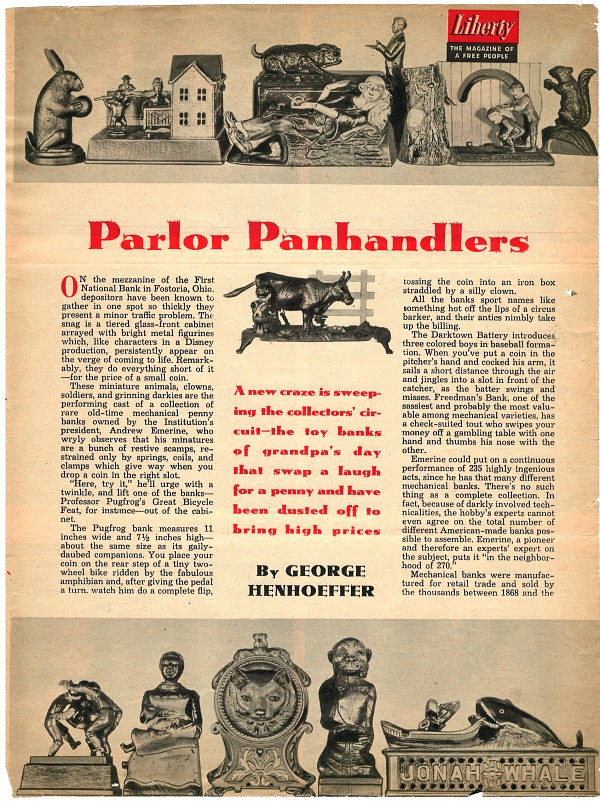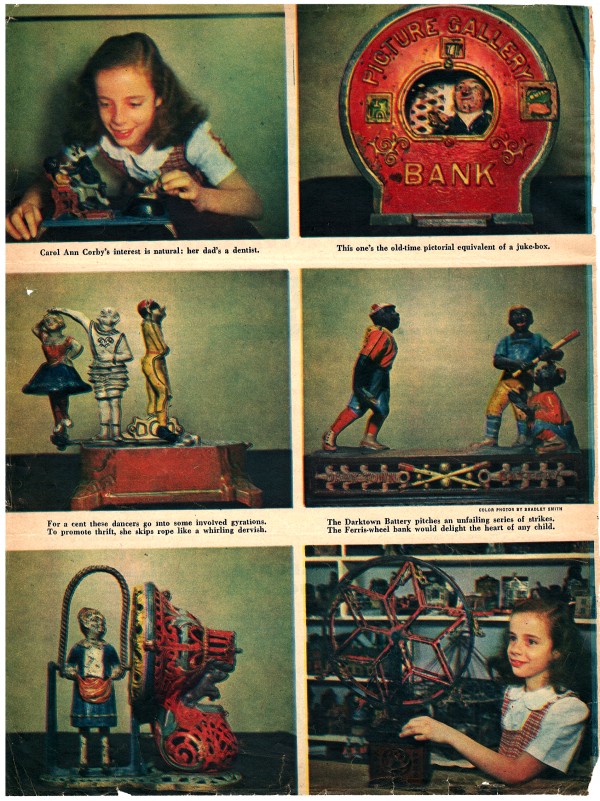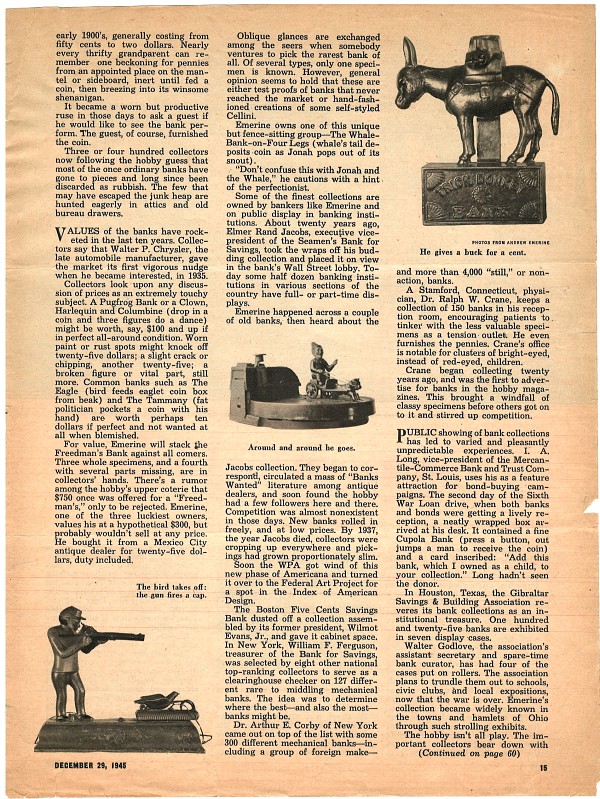Web
Note: See below for text via OCR.




LIBERTY
THE MAGAZINE OF A FREE PEOPLE — December
29, 1945
By GEORGE HENHOEFFER
On the mezzanine of
the First National Bank in Fostoria, Ohio,
depositors have been known to
gather in one spot so thickly they present a
minor traffic problem. The
snag is a tiered glass-front cabinet
arrayed with bright metal figurines which,
like characters in a Disney production,
persistently appear on the verge of coming to
life. Remarkably, they do everything short of
it —for the price of a small coin.
These miniature
animals, clowns, soldiers, and grinning
darkies are the performing cast of a
collection of rare old-time mechanical penny
banks owned by the Institution's
president, Andrew Emerine, who wryly observes
that his miniatures are a bunch of
restive scamps, restrained only by springs,
coils, and clamps which give way when you
drop a coin in the right slot.
"Here, try it," he'll
urge with a twinkle, and lift one of the
banks—Professor Pugfrog's Great Bicycle Feat,
for instance—out of the cabinet.
The Pugfrog bank measures 11
inches wide and 7-1/2 inches high—about
the same size as its gaily-daubed companions.
You place your coin on the rear step of a tiny
two-wheel bike ridden by the fabulous
amphibian and, after giving the pedal
a turn, watch him do a complete flip,
tossing the coin into an iron box straddled by a silly clown.
A new craze is sweeping
the collectors' circuit—the
toy banks of grandpa's day
that swap a laugh for
a penny
and have been dusted off
to
bring high prices
All the banks sport
names like something hot off the lips of a
circus barker, and their antics nimbly take up the billing.
The Darktown
Battery introduces three colored boys in baseball formation. When you've
put a coin in the pitcher's hand and cocked his arm,
it sails a short distance through the air and jingles into a slot in
front of the catcher, as the batter swings and misses. Freedman's Bank,
one of the sassiest and probably the most valuable among mechanical
varieties, has a check-suited tout who swipes your money off a gambling
table with one hand and thumbs his nose with the other.
Emerine could put on
a continuous performance of 235 highly ingenious acts, since he has that
many different mechanical banks. There's no such thing as a complete
collection. In fact, because of darkly
involved technicalities, the hobby's experts cannot even agree on the
total number of different American-made banks possible to assemble.
Emerine, a pioneer and therefore an experts' expert on the
subject, puts it "in the neighborhood of 270."
Mechanical banks were
manufactured for retail trade and sold by the
thousands between 1868 and the early 1900's, generally costing from
fifty cents to two dollars. Nearly every thrifty grandparent can
remember one beckoning for pennies from an appointed place on the mantel
or sideboard, inert until fed a coin, then breezing into its winsome
shenanigan.
It became a worn but
productive ruse in those days to ask a guest if he would like to see the
bank perform. The guest, of course, furnished the coin.
Three or four hundred collectors now following
the hobby guess that most of the once ordinary banks have gone to pieces
and long since been discarded as rubbish. The few that may have escaped
the junk heap are hunted eagerly in attics and old bureau drawers.
VALUES of the banks
have rocketed in the last ten years. Collectors say that Walter P.
Chrysler, the late automobile manufacturer,
gave the market its first vigorous nudge
when he became interested, in 1935.
Collectors look upon any discussion of prices as
an extremely touchy
subject. A Pugfrog Bank or a Clown,
Harlequin and Columbine (drop in a coin
and three figures do a dance) might be worth,
say, $100 and up if in perfect all-around
condition. Worn paint or rust spots might
knock off twenty-five
dollars; a slight crack or chipping,
another twenty-five; a broken figure or vital
part, still more. Common banks such as The
Eagle (bird feeds eaglet coin box from
beak) and The Tammany (fat politician pockets
a coin with his hand) are worth perhaps ten
dollars if perfect and not wanted at
all when blemished.
For value, Emerine
will stack the Freedmans'
Bank against all comers.
Three whole specimens, and a fourth
with several parts missing, are in
collectors' hands. There's a rumor among the
hobby's upper coterie that $750 once was
offered for a "Freedman's," only to be
rejected. Emerine, one of the three luckiest
owners, values his at a hypothetical $300, but
probably wouldn't sell at any price. He
bought it from a Mexico City antique dealer
for twenty-five dollars, duty included.
Oblique glances are
exchanged among the seers when somebody ventures to pick the rarest bank
of all. Of several types, only one specimen is known.
However, general opinion seems to hold that these are either test
proofs of banks that never reached the market or hand-fashioned
creations of some self-styled Cellini.
Emerine owns one of
this unique but fence-sitting group—The Whale
Bank-on-Four Legs (whale's tail deposits coin as Jonah pops out of its
snout).
"Don't confuse this with Jonah and the Whale,"
he cautions with a hint of the perfectionist.
Some of the finest
collections are owned by bankers like Emerine and on public display in
banking institutions. About twenty years ago, Elmer Rand Jacobs,
executive vice-president of the Seamen's Bank for Savings, took the
wraps off his budding collection and placed it on view in the bank's
Wall Street lobby. Today some half dozen banking institutions in various
sections of the country have full- or part-time displays.
Emerine happened
across a couple of old banks, then heard about the
Jacobs collection. They began to correspond, circulated a mass of
"Banks Wanted" literature among antique dealers, and soon found the
hobby had a few followers here and there.
Competition was almost nonexistent in those days. New banks rolled in
freely, and at low prices. By 1937, the year Jacobs died, collectors
were cropping up everywhere and pickings had grown proportionately slim.
Soon the WPA got wind
of this new phase of Americana and turned it over to the Federal Art
Project for a spot in the Index of American
Design.
The Boston Five Cents
Savings Bank dusted off a collection assembled
by its former president, Wilmot Evans, Jr.,
and gave it cabinet space. In New York, William F. Ferguson, treasurer
of the Bank for Savings, was selected by eight other national
top-ranking collectors to serve as a clearinghouse checker on 127
different rare to middling mechanical banks. The idea was to determine
where the best—and also the most— banks might be.
Dr. Arthur E. Corby
of New York came out on top of the list with some 300 different
mechanical banks—including a group of foreign make—and
more than 4,000 "still," or non-action, banks.
A Stamford,
Connecticut, physician, Dr. Ralph W. Crane, keeps a collection of 150
banks in his reception room, encouraging patients to tinker with the
less valuable specimens as a tension outlet. He even furnishes the
pennies. Crane's office is notable for clusters of bright-eyed, instead
of red-eyed, children. Crane began collecting
twenty years ago, and was the first to advertise for banks in the hobby
magazines. This brought a windfall of classy specimens before others got
on to it and stirred up competition.
PUBLIC showing
of bank collections
has led to varied and pleasantly
unpredictable experiences. I. A. Long,
vice-president of the Mercantile-Commerce Bank and Trust Company, St.
Louis, uses his as a feature attraction for
bond-buying campaigns. The second day of the Sixth War Loan drive, when
both banks and bonds were getting a lively reception, a neatly wrapped
box arrived at his desk. It contained
a fine Cupola Bank (press a button, out
jumps a man to receive the coin) and a card inscribed:
"Add this bank, which I owned as a child, to
your collection."
Long hadn't seen the donor.
In Houston, Texas,
the Gibraltar Savings & Building Association reveres
its bank collections as an institutional treasure. One hundred
and twenty-five banks are exhibited in seven display
cases.
Walter Godlove, the
association's assistant
secretary and spare-time bank curator, has had four of the
cases put on rollers. The
association plans to trundle them out to schools, civic clubs,
and local expositions now that the war is
over. Emerine's collection
became widely known in the towns and hamlets of Ohio through such
strolling exhibits.
The hobby isn't all
play. The important
collectors bear down with scientific fervor in the search and
study of government patent records, early novelty
manufacturers' catalogues, and other background data. Emerine has
gathered copies of patent on fifty or more
banks. He owns a half dozen illustrated price
lists of old wholesale firms which originally
marketed the banks as low as three dollars a dozen,
done up smartly in individual wooden boxes.
John D. Meyer, vice-president of the First
Blair County National Bank of Tyrone, Pennsylvania,
is busy gathering material for a handbook
which will consolidate much of this sort of
information.
High adventure in a
collector's life comes with the finding of
some long wanted bank. Many years ago Emerine
had his sights set for a Circus Bank (clown and cart ride the ring,
knocking coin into the box). He had almost
given up hope when one day his wife suddenly remembered a
mechanical toy she and
her brother had played with in Clyde, Ohio.
It was the Circus Bank. Emerine has
since located four more and traded off three to other
collectors.
Crane once found a
rare Goat Bank (billy butts the coin into a
tree stump) in an antique shop while motoring through New England.
WITH the war over,
bank hunters will take to the road again, but Emerine estimates that 95
per cent of all available banks already are in
possession of collectors. This figure
considers only perfect specimens. There might
be quite a few around that would qualify for cabinet space
after a little repair work.
A few collectors do their own repairing,
chiefly in basement shops equipped
with small lathes and miniature iron
foundries. Using a sound part—often
on temporary loan from some friend-collector—talented
hands can produce a duplicate, relieve the
crippled bank of its imperfection, and give it a new
lease on life.
A. W. Pendergast, a
retired optometrist of Terre Haute, Indiana, who first began mending
specimens for himself and his friends, has
built up quite a business and has restored 2,000
broken banks so far mostly for other collectors and at prices
which hint only faintly of commercialism.
Some banks that come
to Pendergast are in a general state of chaos. He
once charged twenty dollars—his
highest price on record—to restore one of
these.
"It was sure sad," he
remembers. "Everything was wrong with it."
But sad banks, happy
banks, healthy banks and ill, all have their places in the heart of a
collector hankering to add a new act to his miniature
penny-cadging hippodrome. And rare banks, like
gold, are where you find them.
THE END |



